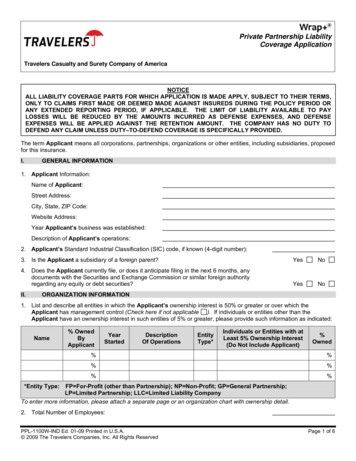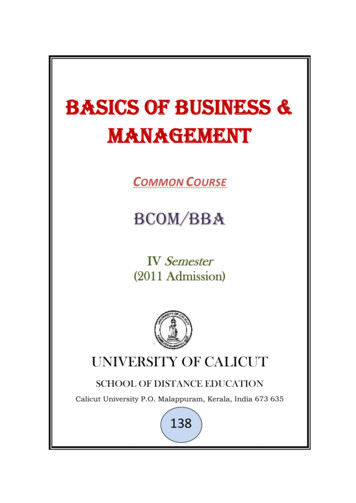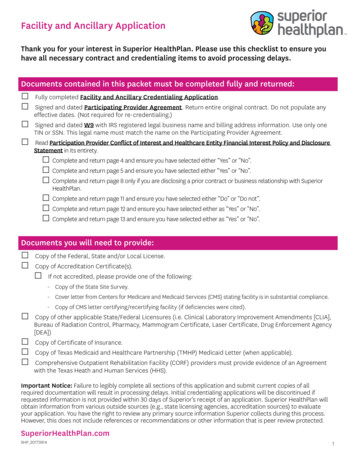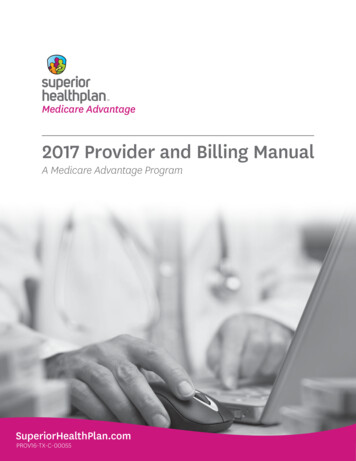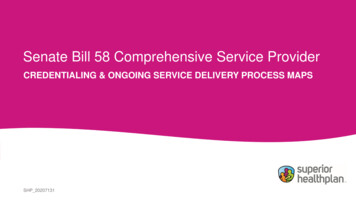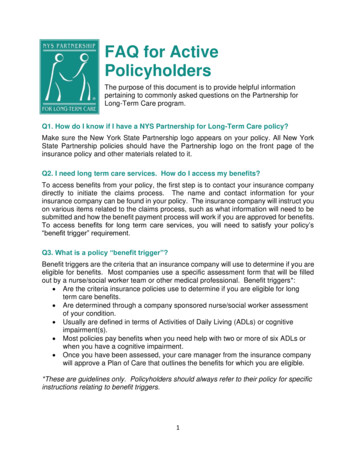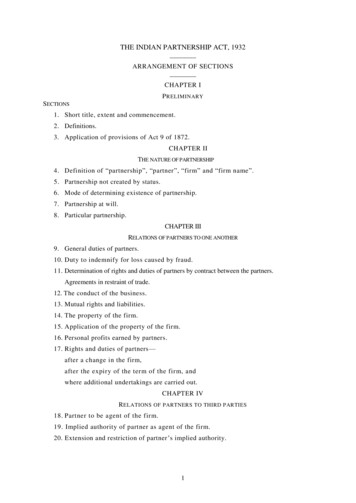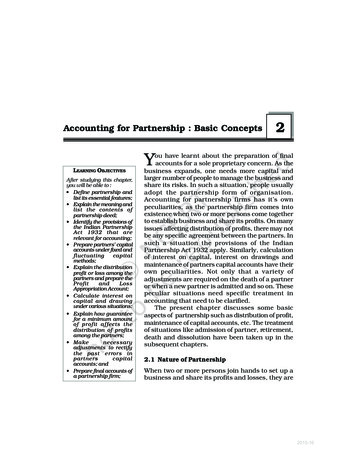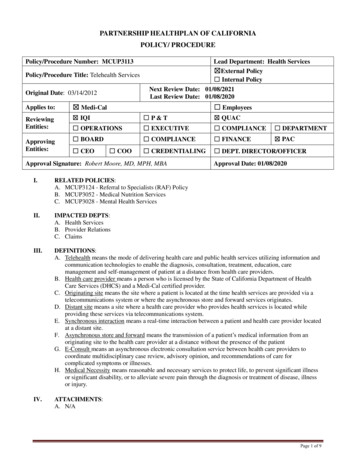
Transcription
PARTNERSHIP HEALTHPLAN OF CALIFORNIAPOLICY/ PROCEDUREPolicy/Procedure Number: MCUP3113Lead Department: Health Services External Policy Internal PolicyPolicy/Procedure Title: Telehealth ServicesNext Review Date: 01/08/2021Last Review Date: 01/08/2020Original Date: 03/14/2012Applies to: Medi-CalReviewingEntities: IQI P&T QUAC OPERATIONS EXECUTIVE COMPLIANCE DEPARTMENT BOARD COMPLIANCE FINANCE PAC CREDENTIALING DEPT. DIRECTOR/OFFICERApprovingEntities: CEO Employees COOApproval Signature: Robert Moore, MD, MPH, MBAApproval Date: 01/08/2020I.RELATED POLICIES:A. MCUP3124 - Referral to Specialists (RAF) PolicyB. MCUP3052 - Medical Nutrition ServicesC. MCUP3028 - Mental Health ServicesII.IMPACTED DEPTS:A. Health ServicesB. Provider RelationsC. ClaimsIII.DEFINITIONS:A. Telehealth means the mode of delivering health care and public health services utilizing information andcommunication technologies to enable the diagnosis, consultation, treatment, education, caremanagement and self-management of patient at a distance from health care providers.B. Health care provider means a person who is licensed by the State of California Department of HealthCare Services (DHCS) and a Medi-Cal certified provider.C. Originating site means the site where a patient is located at the time health services are provided via atelecommunications system or where the asynchronous store and forward services originates.D. Distant site means a site where a health care provider who provides health services is located whileproviding these services via telecommunications system.E. Synchronous interaction means a real-time interaction between a patient and health care provider locatedat a distant site.F. Asynchronous store and forward means the transmission of a patient’s medical information from anoriginating site to the health care provider at a distance without the presence of the patientG. E-Consult means an asynchronous electronic consultation service between health care providers tocoordinate multidisciplinary case review, advisory opinion, and recommendations of care forcomplicated symptoms or illnesses.H. Medical Necessity means reasonable and necessary services to protect life, to prevent significant illnessor significant disability, or to alleviate severe pain through the diagnosis or treatment of disease, illnessor injury.IV.ATTACHMENTS:A. N/APage 1 of 9
Policy/Procedure Number: MCUP3113Lead Department: Health Services External Policy Internal PolicyNext Review Date: 01/08/2021Last Review Date: 01/08/2020 EmployeesPolicy/Procedure Title: Telehealth ServicesOriginal Date: 03/14/2012Applies to:V. Medi-CalPURPOSE:The goal of telehealth is to improve both access and quality health services provided in rural and othermedically underserved areas through the use information and telecommunications technologies. The purposeof this policy is to define telehealth services available to Partnership HealthPlan of California (PHC)members and their general reimbursement policies.In 1996, Medicare initially approved limited coverage for telemedicine services. In the same year, the Stateof California passed the Telemedicine Development Act of 1996 governing the delivery of health careservices through Telemedicine and authorizing terms and conditions of reimbursement of Telemedicineservices under Medi-Cal. In 2005, California broadened the definition of telemedicine services to includestore and forward telemedicine consults for teleopthalmology and teledermatology. Most recently, the Stateapproved AB 415 the Telehealth Advancement Act of 2011 that allows for: The provision of a broader range of telehealth services The expansion of telehealth providers to include all licensed healthcare professionals The expansion of telehealth settings to include physician offices, hospitals, clinics and home settings andother sites The ability of California hospitals to establish medical credentials for telehealth providers more easilyThe Telehealth Advancement Act of 2011 does not limit the type of settings where telehealth services areprovided to patients. Telehealth services may be provided at a physician office, clinic setting, hospital,skilled nursing facility, residential care setting or patient home or other setting and must be in compliancewith all laws regarding the confidentiality of health care information and a patient’s rights to his or hermedical information. There is no longer a need to document a justification for use of telehealth servicesinstead of in-person services. Aside from this, services provided by telehealth must still meet state andfederal guidelines for “medical necessity” and the documentation should support this.VI.POLICY / PROCEDURE:This policy defines key telemedicine/telehealth terms, PHC telehealth covered benefits and, reimbursementpolicies. PHC fully supports the advancement of telehealth services in our region as a means of improvingaccess and quality of care to members as well as providing expert advice and specialty consultation toprimary care providers (PCPs) in the PHC network. Current PHC referral and authorization requirementsapply to telehealth services per policy MCUP3124 Referral to Specialists (Referral Authorization Form[RAF]) Policy.Telemedicine services may be used to provide mild - moderate severity Mental Health Services to PHCmembers. Such services are provided through PHC’s contracted Behavioral Health Managed Servicesorganization(s). See policy MCUP3028 Mental Health Services for additional information.A. Synchronous Telehealth Services and Settings1. Synchronous telehealth services can be provided to PHC members by any PHC credentialed healthcare provider with the member’s verbal consent, as documented in the patient’s medical record.B. Asynchronous Telehealth Services & Settings1. Asynchronous store and forward telehealth services provides for the review of medical informationat a later time by a physician or optometrist at a distant site without the patient being present in realtime. The following Medi-Cal certified health care providers may provide store and forwardservices:a. Ophthalmologistsb. DermatologistsPage 2 of 9
Policy/Procedure Number: MCUP3113Lead Department: Health Services External Policy Internal PolicyNext Review Date: 01/08/2021Last Review Date: 01/08/2020 EmployeesPolicy/Procedure Title: Telehealth ServicesOriginal Date: 03/14/2012Applies to: Medi-Calc.C.D.E.F.G.H.Optometrists (licensed pursuant to Chapter 7 (commencing with Section 3000) of Division 2 ofthe Business and Professions Code)d. Specialists participating in PHC’s E-Consult Program2. Patients receiving teledermatology or teleophthalmology services by store and forward must benotified of the right to interactive communication with the distant specialist if requested. Ifrequested, the communication may occur at the time of the consultation or within 30 calendar daysof the patient’s notification of the results of the consultation.E-Consult Telehealth Services & Settings1. E-consult telehealth services fall under the auspice of store and forward services and provide theability for health care providers at the originating and distant site to review medical information forcomplicated symptoms or illnesses without the patient being present in real time. A health careprovider at a distant site may bill for an E-consult with the appropriate CPT/HCPCS code when thebenefits or services delivered meet the procedural definition and components of the nationalCPT/HCPCS code as defined by the American Medical Association (AMA) or any other extendedguideline described in the Medi-Cal provider manual. Verbal consent for telehealth services is arequirement and must be documented by both the originating and distant site in the patient medicalrecord.Consent1. Prior to the delivery of health care services via telehealth, the health care provider at the presentationsite must verbally inform the patient that telehealth may be used and obtain verbal consent from thepatient for this use. The verbal consent must be documented in the patient’s medical record.Confidentiality1. All federal and state laws regarding the confidentiality of health care information and a patient’srights to his or her medical information apply to telehealth services.Credentialing of Providers of Telehealth Services to PHC Members in a Hospital Setting1. Licensed health care providers providing telehealth services to Partnership HealthPlan members,outside a hospital setting, need to be a Medi-Cal certified provider in the State of California and aqualified provider credentialed through Partnership HealthPlan, or an organization with delegatedauthority for credentialing, as approved by the Partnership HealthPlan Credentials Committee.2. The governing body of the hospital whose patients are receiving telehealth services may grantprivileges to, and verify and approve credentials for, providers of telehealth services based on itsmedical staff recommendations that rely on information provided by the distant site hospital ortelehealth entity, as described in Sections 482.12, 482.22 and 485.616 of Title 42 of the Code ofFederal Regulations.Required Equipment1. The audio-video telemedicine system used, must, at a minimum, have the capability of meeting theprocedural definition of the code provided through telehealth. The telecommunication equipmentmust be of a quality to adequately complete all necessary components to document the level ofservice for the Current Procedural Terminology (CPT) code billed.Reimbursement for Telehealth Services1. There are three main models of telehealth services available to PHC members.a. The first, called “Traditional Synchronous Telehealth Services” connects the patient with adistant provider of health services through audio-video equipment on a real-time basis. Thismodel is commonly used between specialty centers such as University of California (UC)San Francisco or UC Davis with outlying physician offices or community health centers.b. The second model, called “Asynchronous Telehealth Services” or the “Store and Forward”model connects a patient with a distant provider of radiology, electrocardiography,ophthalmology, dermatology or certain optometry services using audio-video equipment, but noton a real-time basis. Generally, an image or picture is taken and forwarded to the specialtyPage 3 of 9
Policy/Procedure Number: MCUP3113Lead Department: Health Services External Policy Internal PolicyNext Review Date: 01/08/2021Last Review Date: 01/08/2020 EmployeesPolicy/Procedure Title: Telehealth ServicesOriginal Date: 03/14/2012Applies to:I. Medi-Calprovider to review at a later time. This also includes specialty services provided via E-Consult,or electronic consultations, which consist of an electronic exchange of information through theE-Consult platform and may include images or photos, labs, and other relevant patientinformation.c. The third model called “Synchronous Patient to Provider Telehealth Services” connects a singleprovider (primary care or specialty provider) to a patient using audio-visual equipment on a realtime basis. The patient can be in a health facility, residential group home or private residence orother setting, provided the appropriate equipment is used. The reimbursement terms for each ofthe three models are summarized below:Reimbursement for Traditional Synchronous Telehealth ServicesOriginating Site Distant SitePatient presentProvideroptional Provider ofserviceBilling guidelines for Originating Site Providers:Originating SiteCodeQ3014 (once per day, per patient, same provider)T1014 (per minute for maximum of 90 min. per patient, per day,same provider)***Licensed provider fee (if present)E&M codes 99201 - 99215 and other CPT codes for servicesdistinct and in addition to those rendered by the Distant SiteProvider.***Note that FQHC/RHC/IHS cannot bill for site fee or transmission charges. These charges are included intheir FQHC/RHC PPS rate or the IHS MOA rate.ServiceSite facility feeTransmission CostIf a Licensed provider also is present at the telehealth Originating Site with the patient present and a progressnote is generated by the originating provider, the visit is reimbursable. The scope of the interaction with theoriginating provider should be documented in the progress note that are distinct from those provided by theDistant Site and will be the basis of the Evaluation and Management (E&M) and other CPT code(s) billed.If an E&M code is included, the transmission cost fees may be billed. No modifier is needed at theOriginating Site.Health care providers are required to document place of service code 02 on the claim, which indicates thatservices were provided or received through a telecommunications system. The Place of Service Code 02requirement is not applicable for FQHCs, RHCs or Indian Health Services (IHS).Page 4 of 9
Policy/Procedure Number: MCUP3113Lead Department: Health Services External Policy Internal PolicyNext Review Date: 01/08/2021Last Review Date: 01/08/2020 EmployeesPolicy/Procedure Title: Telehealth ServicesOriginal Date: 03/14/2012Applies to: Medi-CalBilling guidelines for Distant Site ProvidersCodeT1014 (per minute for maximum of 90 min. perpatient, per day, same provider)Inpatient hospital: 99221 – 99233Initial hospital care or subsequent hospital care,critical care (new or established patient)Critical care: 99291 or G0508; 99292 or G050999356 - 99357Extended Inpatient CareConsultations: Office or other outpatient ( initial99241 – 99275or follow-up) Inpatient, and confirmatoryS0265Genetic CounselingNutrition Counseling per PHC Guidelines (See97802, 97803, 97804Policy MCUP3052)All CPT codes (except for these ExcludedOther Covered Procedures that can be providedcodes**: Anesthesia: 00100-01999 and 99100by telemedicine*99157; Surgery: 10021-69990;Speech/Occupational/Physical Therapy: 96101to 97546, and 97750 to 97799; Wound care:97597 to 97610; Acupuncture, osteopathicmanipulation, chiropractic manipulation:97810 to 98943) are potentially allowed if theymeet requirements as noted*Video visit with patient provider in office andG0071 (FQHC and RHC)patient remote from office (in lieu of office visit)G2012 (other providers)Required Modifier95 modifier required for all CPT-Codes exceptTransmission Cost codes and G0071 and G2012ServiceTransmission Cost* Each telehealth provider must be licensed in the State of California, enrolled as a Medi-Cal provider,and must reside in California (or a border community). PHC covered services, identified by CurrentProcedural Terminology – 4th Revision (CPT-4) or Healthcare Common Procedure Coding System(HCPCS) codes and subject to any existing treatment authorization requirements, may be provided via atelehealth modality if all of the following criteria are satisfied:1. The treating health care provider at the distant site believes the services being provided are clinicallyappropriate to be delivered via telehealth based upon evidence-based medicine and/or best clinicaljudgment;2. The services delivered via telehealth meet the procedural definition and components in the CPT-4 orHCPCS code(s) associated with the covered service; and3. The services provided via telehealth meet all laws regarding confidentiality of health careinformation and a patient’s right to the patient’s own medical information.**Certain types of services cannot be appropriately delivered via telehealth. These include services thatwould otherwise require the in-person presence of the patient for any reason, such as services performedin an operating room or while the patient is under anesthesia, where direct visualization orinstrumentation of bodily structures is required, or procedures that involve sampling of tissue orinsertion/removal of medical devices. A provider must assess the appropriateness of the telehealthmodality to the patient’s level of acuity at the time of the service.Page 5 of 9
Policy/Procedure Number: MCUP3113Lead Department: Health Services External Policy Internal PolicyNext Review Date: 01/08/2021Last Review Date: 01/08/2020 EmployeesPolicy/Procedure Title: Telehealth ServicesOriginal Date: 03/14/2012Applies to: Medi-CalNote: A Federally Qualified Health Center (FQHC)/ Rural Health Center (RHC)/Tribal health site maychoose to sub-contract with a specialist and pay them directly. Under these circumstances, theFQHC/RHC would bill for the originating site and the specialty service on two separate claims.Designated telehealth specialist providers Referral Authorization Form (RAF) requirements vary, seepolicy MCUP3124 Referral to Specialists (RAF) Policy. The PHC system would need to be set up forthe specific specialty and if not, the Provider Relations Department should be contacted.J.Reimbursement for Asynchronous Telehealth Services (Store and Forward) for Teleophthalmology,Teleoptometry, Teledermatology, Radiology, Electrocardiography and E-Consult Program ServicesDistant SiteOriginating Site Patient presentProvideroptionalInformation stored andforwarded to Distant Site Provider ofserviceBilling guidelines for Originating Site Providers:Originating SiteServiceSite facility feeLicensed provider fee (if present)CodeQ3014E&M codes 99201 - 99215 and other CPTcodes for services distinct and in addition tothose rendered by the Distant Site Provider.Health care providers are required to document place of service code 02 on the claim, which indicates thatservices were provided or received through a telecommunications system. The Place of Service Code 02requirement is not applicable for FQHCs, RHCs or Indian Health Services (IHS).If a Licensed provider also is present at the telehealth Originating Site, with the patient present and aprogress note generated by the originating provider, the visit is reimbursable as a visit. The scope of theinteraction with the originating provider should be documented in the progress note, and will be the basis ofthe CPT code(s) used. If a CPT code is included, the originating site fee and the transmission cost fees maystill be billed. No modifier is needed.Note: Originating site and transmission fee restrictions and billing rules are not applicable for FQHCs, RHCsor IHS. Services provided through telehealth are subject to the same program restrictions, limitations andcoverage that exist when the service is provided in-person. For policy information specific to FQHCs, RHCs,or IHS, please see the Medi-Cal provider manual.Special Billing Guidelines for Asynchronous Retinal Photography - Originating Site Providers:If a provider uses asynchronous telehealth for diabetic eye exam screenings, through the use of a retinalcamera located at the originating site, special billing guidelines apply, when the originating site is paying thespecialist directly for reading the results of the retinal photographs. A licensed provider does not need to bepresent for retinal photography service to be reimbursable. If no provider is present at visit, bill using thefollowing CPT codes:Page 6 of 9
Policy/Procedure Number: MCUP3113Lead Department: Health Services External Policy Internal PolicyNext Review Date: 01/08/2021Last Review Date: 01/08/2020 EmployeesPolicy/Procedure Title: Telehealth ServicesOriginal Date: 03/14/2012Applies to: Medi-CalOriginating Store and Forward SiteServiceCPT CodesRetinal photography with interpretation for92250 (Do not use modifier)services provided by optometrists orophthalmologistsORRemote imaging for detection ofretinal disease with analysis and92227 (Do not use modifier)report under physician supervision,unilateral or bilateralSite facility feeTransmission CostQ3014T1014 (per minute for maximum of 90min. per patient)If provider is present at visit, E&M codes can also be billed as usual. The scope of the interaction with theoriginating provider should be documented in the progress note. The originating site fee and thetransmission cost fees may still be billed. No modifier is needed.Billing guidelines for Distant Store and Forward Site Providers:Distant Store and Forward SiteServiceOffice consultation, new or established patientFollow up hospital visitRemote evaluation of recorded video and/or images submitted bythe patient.Retinal photography with interpretation for services provided byoptometrists or ophthalmologists (should not be used if originatingsite is submitting claims with this code).Required Modifier:CPT Codes99241 – 9924399231 – 99233G201092250All asynchronous, store-andforward services are billed with a“GQ” modifierSpecial Billing Guidelines for Asynchronous E-Consult service - Distant Site Providers:The health care provider at the distant site must:1. Create and maintain record of the review and analysis of the transmitted information with writtendocumentation of data of service and time spent (between 5-30 minutes)2. Record of preparing a written report of case findings and recommendations with conveyance to theoriginating site3. Record of maintenance of transmitted medical records in patient’s medical record.Only approved specialists participating in PHC’s E-Consult Program can bill using the following CPTcode:Page 7 of 9
Policy/Procedure Number: MCUP3113Lead Department: Health Services External Policy Internal PolicyNext Review Date: 01/08/2021Last Review Date: 01/08/2020 EmployeesPolicy/Procedure Title: Telehealth ServicesOriginal Date: 03/14/2012Applies to: Medi-CalDistant Store and Forward SiteServiceE-Consult, electronic consultationRequired Modifier:CPT Codes99451“GQ” modifierK. Reimbursement for Synchronous: Provider to Patient Telehealth ServicesTelehealth Advancement Act of 2011 allows for telehealth services to be provided between a qualifiedprovider and patient at a distant location. The location may be a health facility, residential home,patient’s home or other location.Originating Site Patient Location Health facility Residentialhome Patient home Other locationProvider Site Provider SitePatient NOTpresentBilling Guidelines for the Provider Site:Provider SiteServiceTransmission CostLicensed provider fee (if present)Nutrition Counseling per PHC Guidelines(See Policy MCUP3052)Required ModifierCodeT1014 (per minute for maximum of 90 min.per patient, per day, same provider)E&M codes 99201 – 9921597802, 97803, 97804, 9953995 modifier required for all CPT-Codesexcept Transmission Cost codesA licensed provider who provides E&M services for a patient utilizing telehealth technology to accessthe provider’s office may submit claims for this service using the E&M code, without the modifier. Thecontracted arrangements for primary care providers and specialty providers continue to apply.T1014 Transmission Cost fee may also be billed.L. Telephone visitsAny clinician eligible to bill for office visits may conduct a telephone visit with a patient in lieu of anoffice visit. Such telephone visits must last at least 5 minutes, and be documented in the medical record.Note that these are the same codes used for video visits with the patient at home.Billing guidelines for Distant Site ProvidersServiceCodeTelephone visit with provider in office andG0071 (FQHC and RHC)patient remote from office (in lieu of office visit)G2012 (other providers)Required modifierModifiers are not required on G0071 and G2012services.Page 8 of 9
Policy/Procedure Number: MCUP3113Lead Department: Health Services External Policy Internal PolicyNext Review Date: 01/08/2021Last Review Date: 01/08/2020 EmployeesPolicy/Procedure Title: Telehealth ServicesOriginal Date: 03/14/2012Applies to: Medi-CalM. ExclusionsPHC does not cover communication between providers outside that described above as E-Consult. PHCdoes not cover patient-provider communication via email, text, or written communication. Videocommunication of poor resolution and phone communication are only covered if they meet the criteria insection L. above.VII.REFERENCES:A. Medi-Cal Provider Manual: Medicine: Telehealth (medne tele) Last updated January 2019B. Title 42 of the Code of Federal Regulations Sections 482.12, 482.22 and 485.616C. Department of Health Services (DHCS) All Plan Letter (APL) 19-009 Revised: Telehealth ServicesPolicy (10/16/2019)VIII.DISTRIBUTION:A. PHC Provider ManualB. PHC Department DirectorsIX.POSITION RESPONSIBLE FOR IMPLEMENTING PROCEDURE: Chief Medical OfficerX.REVISION DATES:3/14/12, 2/18/15; 01/20/16; 04/20/16; 09/21/16; 9/20/17; *10/10/18; 08/14/19; 01/08/20*Through 2017, Approval Date reflective of the Quality/Utilization Advisory Committee meetingdate. Effective January 2018, Approval Date reflects that of the Physician Advisory Committee’s meetingdate.PREVIOUSLY APPLIED TO: N/A***********************************In accordance with the California Health and Safety Code, Section 1363.5, this policy was developed withinvolvement from actively practicing health care providers and meets these provisions: Consistent with sound clinical principles and processesEvaluated and updated at least annuallyIf used as the basis of a decision to modify, delay or deny services in a specific case, the criteria will bedisclosed to the provider and/or enrollee upon requestThe materials provided are guidelines used by PHC to authorize, modify or deny services for persons with similarillnesses or conditions. Specific care and treatment may vary depending on individual need and the benefitscovered under PHC.PHC’s authorization requirements comply with the requirements for parity in mental health and substance usedisorder benefits in 42 CFR 438.910.Page 9 of 9
PARTNERSHIP HEALTHPLAN OF CALIFORNIA POLICY/ PROCEDURE Page 1 of 9 Policy/Procedure Number: MCUP3113 Lead Department: Health Services Policy/Procedure Title: Telehealth Services External Policy Internal Policy Original Date: 03/14/2012 Next Review Date: 01/08/2021

